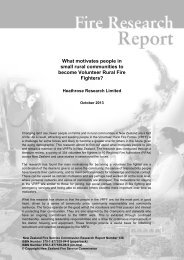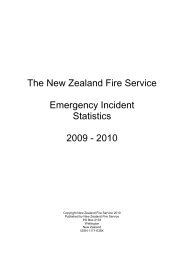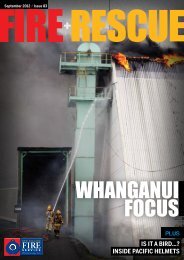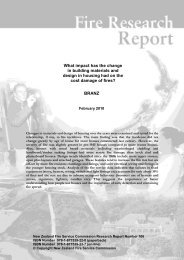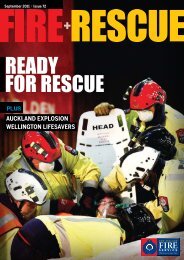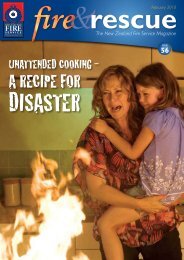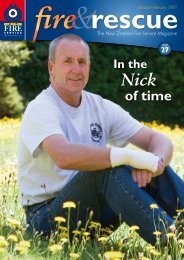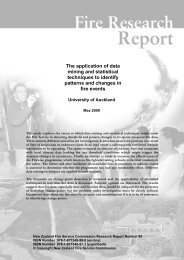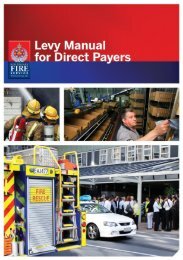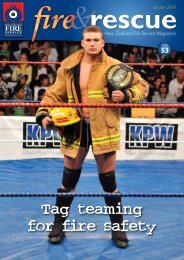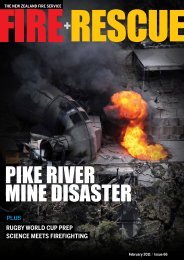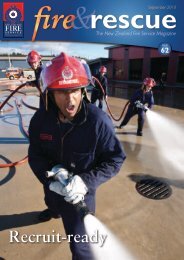Issue 86 - New Zealand Fire Service
Issue 86 - New Zealand Fire Service
Issue 86 - New Zealand Fire Service
You also want an ePaper? Increase the reach of your titles
YUMPU automatically turns print PDFs into web optimized ePapers that Google loves.
December 2012 / <strong>Issue</strong> <strong>86</strong><br />
Crash<br />
alert<br />
Plus<br />
AntArctIc fIrefIghtIng<br />
type 1 prototype unveIleD<br />
frIDge explosIon whoDunIt
the new zeAlAnD fIre servIce<br />
<strong>Fire</strong>+Rescue is the flagship<br />
publication of the <strong>New</strong> <strong>Zealand</strong><br />
<strong>Fire</strong> <strong>Service</strong>.<br />
It is produced by Media,<br />
Promotions and Communications,<br />
National Headquarters,<br />
Level 9, 80 The Terrace, Wellington.<br />
contrIbutIons to fIre+rescue<br />
We welcome ideas for articles, news<br />
and events that would be of interest to<br />
other <strong>Fire</strong> <strong>Service</strong> staff and volunteers.<br />
Draft articles and photos (pictures<br />
need to be at least 1MB) can be<br />
emailed to fire.rescue@fire.org.nz or<br />
contact the editor Karlum Lattimore<br />
on 04 496 3702.<br />
Post written material and photos,<br />
or photo CDs to:<br />
<strong>Fire</strong>+Rescue magazine,<br />
PO Box 2133, Wellington.<br />
(These will be returned on request.)<br />
www.fIre.org.nz<br />
All material in <strong>Fire</strong>+Rescue magazine<br />
is copyrighted and may not be<br />
reproduced without the permission<br />
of the editor.<br />
ISSN: 1176-6670 (Print)<br />
ISSN: 1177-<strong>86</strong>79 (Online)<br />
front cover<br />
Debris from a fatal B train crash<br />
sets off environment pollution alert.<br />
Photo: Turangi Brigade.<br />
2 / <strong>Fire</strong>+Rescue / December 2012<br />
alarm bells<br />
Forgot to turn<br />
the stove off<br />
A small, portable oven left on at a very low heat for almost two months is thought<br />
to have been the cause of a fire that gutted the top storey of an unoccupied house<br />
in Queenstown in September.<br />
Southern Region <strong>Fire</strong> Safety Officer Stuart<br />
Ide said that he and his <strong>Fire</strong> <strong>Service</strong> and<br />
Police colleagues first thought the fire was<br />
suspicious but a look at the power bill and<br />
the meter indicated human error was the<br />
most likely cause. The kitchen area of the<br />
house was burnt out which also supported<br />
the theory.<br />
“It seems that the small electric stove had<br />
been left on in the ‘low’ position. The<br />
contact would have been opening and<br />
closing, clicking on and off repeatedly.<br />
There was probably something<br />
combustible like a piece of paper nearby<br />
and we think that the heat generated by<br />
the stove, even at that low heat, would<br />
have been enough to start a fire.<br />
The rental property was unoccupied at the<br />
time so no one was hurt but the absentee<br />
owner of the ‘50s era holiday home lost<br />
everything in the blaze.<br />
“Its an unfortunate outcome for the owner<br />
but a salutary fire safety lesson and a<br />
reminder that when it comes to electrical<br />
appliances ‘off means off’ and ‘almost’ can<br />
be downright dangerous,” Stuart said.
news<br />
from the top<br />
I am now almost at the end of my first year as Chief Executive<br />
and National Commander.<br />
2012 has been incredibly challenging and<br />
rewarding. Everyone has worked<br />
extremely hard to bring about massive<br />
organisational changes. As we head into<br />
2013 we are still transitioning to the new<br />
structures but with more understanding<br />
of the vision and the benefits.<br />
I heard about one new Volunteer<br />
Support Officer recently, a former<br />
Senior Station Officer, who saw a career<br />
path opening up following the<br />
restructure. Instead of perhaps only<br />
being able to consider progression to<br />
Assistant Area Manager, he saw the<br />
refocused VSO role as a real opportunity<br />
to make a difference at the grass roots.<br />
So far, he’s finding it incredibly<br />
rewarding and is thoroughly enjoying<br />
the fresh perspective he’s getting.<br />
This type of new opportunity is just one<br />
of the benefits of the restructure. Our<br />
new Career Board will be used to<br />
identify future leaders and managers<br />
and help them grow into those roles. I<br />
am committed to working closely with<br />
the NZPFU on this initiative – finding<br />
the right people to fill our future<br />
leadership roles is crucial to this<br />
organisation’s success and wellbeing.<br />
One of the barriers to people<br />
progressing through the organisation<br />
has been the ‘them and us’ syndrome.<br />
We are a ‘people rich’ organisation and<br />
yet we often struggle to find a good pool<br />
of well-qualified candidates for<br />
leadership positions.<br />
I believe that if the rank and file want<br />
good, strong leadership, then they, too,<br />
need to be thinking about who among<br />
them would make good future leaders<br />
and managers. It would be great to see<br />
the union working in partnership with<br />
the organisation to identify, support and<br />
develop the next generation of leaders.<br />
It would be interesting wouldn’t it – to<br />
start thinking about who you would<br />
want as your manager and helping that<br />
person to get there?<br />
editorial<br />
Frankly, I am keen to develop a<br />
partnership with the NZPFU. It is time<br />
to put historical attitudes and<br />
grievances behind us and work more<br />
constructively on the shared challenges<br />
that confront us.<br />
We need to be united if we are to<br />
become the truly national fire and<br />
emergency service that the Government<br />
and the public expect us to be. Our<br />
experience in Christchurch has shown<br />
us that the different elements of the<br />
NZFS could have worked more closely<br />
together to achieve our common<br />
purpose. We did well, but we could have<br />
done even better. Let’s make sure that<br />
we learn from this and grow into an<br />
exceptional emergency service.<br />
Enjoy the holiday season and best<br />
wishes for 2013.<br />
Paul Baxter<br />
Chief Executive & National Commander<br />
<strong>Fire</strong>+Rescue / December 2012 / 3
feature<br />
Environmental apocalypse<br />
averted<br />
<strong>Fire</strong>fighters turn out in all weathers to all kinds of incidents and often don’t know<br />
quite what they’ll find when they arrive.<br />
The 4.22am call out on 8 October to a<br />
truck crash on the Desert Road was<br />
no different. The Turangi Brigade<br />
turned out with its two pumps and the<br />
support vehicle a few minutes later.<br />
Chief <strong>Fire</strong> Officer Tong Kingi said the first<br />
appliance arrived half an hour later to a<br />
chaotic scene – a huge backlog of trucks<br />
on State Highway One, a truck and its two<br />
trailers over the side of a bridge, massive<br />
amounts of debris down a gorge, the driver<br />
is missing, and all in total darkness apart<br />
from a few headlights.<br />
4 / <strong>Fire</strong>+Rescue / December 2012<br />
“One of the truck drivers held up by the<br />
crash had managed to get the manifest<br />
out of the crashed truck and it showed the<br />
45 tonne load included hazardous<br />
chemicals. The truck signage was showing<br />
the radioactive goods warning.<br />
“We were in a communication black spot<br />
so a police officer drove a short distance<br />
up the road to make cellphone calls<br />
through to their Comcen who relayed the<br />
information on to <strong>Fire</strong> Coms.”<br />
Meanwhile, Turangi Brigade Chief <strong>Fire</strong><br />
Officer Tong Kingi carefully assessed the<br />
site, and the obvious risks. “There were no<br />
indications of any leakage of chemicals<br />
around the truck and the 10–15 people on<br />
the bridge all seemed fine. We went<br />
through the manifest, which took quite a<br />
long time because there was a lot on<br />
board, and the handwriting was pretty bad.<br />
We spotted the load included two types of<br />
chemicals that were a potential danger to<br />
the environment and got that information<br />
through to the Comcen. But there was no<br />
sign of anything radioactive, apart from<br />
some smoke alarms. I was pretty certain<br />
the truck’s hazmat sign had flipped to the<br />
radioactive warning in the crash, so we got<br />
word out to the relevant environmental<br />
authorities and to our Comcen about the<br />
chemicals.”
The Rotorua hazmat/command unit was<br />
dispatched at about 5.30am and<br />
appliances from Rotorua sent out shortly<br />
after 6am.<br />
Tong said, in the daylight, they could see<br />
that the three containers of a pool cleaning<br />
chemical Trichlore were in the stream and<br />
appeared to be intact. This was a relief as it<br />
had the potential to kill fish and other<br />
wildlife. The dozen small canisters on<br />
board that contained a pesticide used<br />
in fly spray were thought to be in the<br />
debris somewhere but were not a<br />
danger to people.<br />
By 6.30am, Tong’s plan of action was<br />
pretty clear. The brigade had done all it<br />
could, it was up to the contractors to clear<br />
the debris and search teams to find the<br />
missing driver. The environmental<br />
agencies had arrived and others were on<br />
their way. The Police didn’t want the scene<br />
disturbed before they found the driver, so<br />
Tong handed over to Police. “Waiouru’s<br />
appliance and one of the Turangi pumps<br />
were released. I left the other Turangi<br />
appliance behind with Deputy Chief <strong>Fire</strong><br />
Officer Michelle Sherwood and headed<br />
home.” Michelle (Micky) would leave once<br />
the crews from Rotorua arrived.<br />
CatChing the news<br />
Tong said it wasn’t until he was several<br />
kilometres down the road when his<br />
communications link came back up that he<br />
found that the mention of possible<br />
radioactive goods by Police to their<br />
Comcen had sparked a national surge of<br />
adrenaline.<br />
“I heard the radio notification that the<br />
assistant area manager and the Rotorua<br />
hazmat/command unit were almost at the<br />
scene. It was the first I knew that the rest<br />
of the world had gone to ‘Defcon 3’.”<br />
Central Lakes Assistant Area Manager<br />
Nigel Richards, was paged just before<br />
5.20am, it was not clear just what the<br />
hazmat situation was so the hazmat/<br />
command unit was mobilised along with<br />
its accompanying appliances.<br />
“When I heard there was possibly<br />
radioactive goods on board, I did take a<br />
breath.” It took the next wave of support<br />
about an hour and a half to get to the<br />
remote spot on the Desert Road at the<br />
Waiohohonu Bridge.<br />
“Once I got there I liaised with Police and<br />
went through the manifest again and then<br />
made a plan of what was where. We<br />
located the 50kg containers of Trichlore in<br />
the stream, looked again at the possibility<br />
of there being any radioactive goods and,<br />
like Tong, realised it was just the sign on<br />
the truck that had flipped over in the crash<br />
to show the radioactive symbol.”<br />
Nigel said, once again, the<br />
communications technology on board the<br />
feature<br />
hazmat/command unit proved invaluable.<br />
The satellite link allowed all the different<br />
agencies to keep in touch with their home<br />
bases and pass information to and fro as<br />
the clean up, search and body recovery<br />
were underway.<br />
“The incident also put to good use all the<br />
inter-agency training and relationship<br />
building that we do”, said Nigel.<br />
Nigel Richards. Michelle Sherwood and Tong Kingi.<br />
<strong>Fire</strong>+Rescue / December 2012 / 5
cApture the kIDs<br />
the parents will follow<br />
Brigades around the country are always trying to think of new ways to bring in fresh recruits.<br />
Muriwhenua Volunteer Support<br />
Officer Brad Mosby says some<br />
brigades in Northland are really<br />
struggling to keep up the numbers of<br />
available firefighters, particularly for<br />
daytime call outs.<br />
So when he, the Ahipara and Kaitaia<br />
Brigades and Sky Tower Stair Climb<br />
promoter Tony Scott put their heads<br />
together they came up with a winner.<br />
Tony Scott (a firefighter at Auckland<br />
airport and new volunteer at Kawakawa)<br />
has a longtime interest in promoting<br />
firefighter challenges (Sky Tower and Chill<br />
Factor). Over the last few years, he’s been<br />
developing a mini firefighters combat<br />
challenge circuit for children, based on the<br />
international event promoted by the<br />
United <strong>Fire</strong> Brigades Association.<br />
Ahipara’s biggest annual event is the<br />
school gala. Brad and the Ahipara and<br />
Kaitaia Brigades thought providing the<br />
kids with a free, fun challenge would mean<br />
the parents would come along and watch.<br />
“That would give us an ideal opportunity to<br />
start talking with them about the volunteer<br />
brigade, what we do and what part they<br />
6 / <strong>Fire</strong>+Rescue / December 2012<br />
might be able to play in the brigade and<br />
their community,” said Brad.<br />
The end result, dozens of happy kids ran<br />
up and down lanes hauling dummies,<br />
clambered up scaffolding with hose,<br />
pounded on steel with sledgehammers<br />
and did all the other elements of a real<br />
<strong>Fire</strong>fighter Combat Challenge – child-sized<br />
of course.<br />
Brad was delighted. “We have six people<br />
now interested in joining the Kaitaia<br />
Brigade and two for Ahipara, so we’re<br />
following up with them now.”<br />
For Tony Scott, it was a good endorsement<br />
of his mini combat challenge circuit. It’s<br />
already booked for another outing at<br />
Waitangi on 6 February (Waitangi Day) and<br />
the horse races at Hokianga on 2 March.<br />
The recruitment drive was combined with<br />
a fire safety promotion at the event which<br />
included the kitchen fire demonstrator to<br />
help attract the crowds, said Brad.<br />
<strong>Fire</strong> Risk Management Officer Gary Beer,<br />
who is fluent in Te Reo Ma- ori, was able to<br />
give all the fire safety messages in both<br />
English and te reo, something the locals<br />
really appreciated.<br />
Ahipara is remote and includes<br />
communities most at risk of experiencing<br />
a fire so the NZFS personnel were pleased<br />
that people took a keen interest in the<br />
‘unattended cooking kills’ and ‘don’t drink<br />
and fry’ messages being promoted –<br />
helped along by a competition for a $200<br />
fire safety package.
more gAs Detectors<br />
Rolling out<br />
South Island hazmat crews<br />
around the country are now<br />
being issued with the new<br />
photoionisation detectors<br />
(PIDs) and the North Island<br />
crews will receive theirs early<br />
next year.<br />
National Hazardous Substance Advisor<br />
Dick Thornton-Grimes said the PIDs<br />
come with two days of training as well<br />
as a training/technical manual.<br />
The PIDs have been used very<br />
successfully by specialist fire<br />
investigators to test for accelerants at<br />
fires. Hazmat crews will use them to test<br />
for a broad range of flammable and<br />
toxic substances.<br />
When this roll out is complete, there will<br />
be almost 380 various types of gas<br />
detection instruments in use around the<br />
country – 36 of them are the new PIDs.<br />
Dick is particularly proud of the manual<br />
that comes with the device. “The <strong>New</strong><br />
<strong>Zealand</strong> <strong>Fire</strong> <strong>Service</strong> and the supplier,<br />
APC Techsafe, worked together on the<br />
manual to produce something that went<br />
beyond the usual technical details. As a<br />
result, it incorporates good advice on<br />
how hazmat officers and specialist fire<br />
investigators can actually use the<br />
equipment.”<br />
Dick said because NZFS required a tool<br />
that could stand up to the rigours of<br />
various incidents, APC has developed<br />
in-case charging, which means the<br />
equipment is constantly ready to go<br />
when needed but protected from the<br />
hazards of responding to incidents.<br />
NZFS has just renewed its supply<br />
contract with APC Techsafe and this<br />
includes mobile servicing,<br />
APC Techsafe Manager Dean Pritchard<br />
said, “We are committed to providing<br />
local solutions to the regions with a<br />
mobile testing facility that will reduce<br />
the disruption of testing by moving<br />
equipment around. During November<br />
we launched our second mobile<br />
testing service, this one based in<br />
the South Island.”<br />
Dick said the addition of a technican in<br />
the South Island means servicing and<br />
testing will be done at a fire station,<br />
rather than staff having to send the<br />
equipment to Auckland.<br />
Above: APC Techsafe senior technician Dylan<br />
Owen shows an Auckland firefighter through the<br />
testing van’s set up.<br />
new<br />
reImbursement<br />
polIcy<br />
Improvements have been made<br />
to the way volunteer<br />
firefighters are reimbursed for their<br />
costs while they are away on national<br />
training courses.<br />
Deputy National Commander Paul<br />
McGill said, “Feedback from individual<br />
volunteers, our volunteer<br />
sustainability project and the<br />
volunteer reference group has been<br />
fairly consistent. We needed to make<br />
our reimbursement system fairer and<br />
more flexible so that it better reflected<br />
their actual costs.”<br />
The new policy, which takes effect in<br />
January, removes the threshold for<br />
claims for loss of income, which was<br />
based on the average wage.<br />
“This means that self-employed<br />
volunteer firefighters, and those on<br />
higher than average incomes will be<br />
fully compensated for their loss of<br />
income, or annual leave, while away<br />
on national training courses,” said<br />
Paul.<br />
The changes also make it easier for<br />
people to claim for child care or other<br />
dependant care costs.<br />
“We are also reducing the paperwork<br />
needed to make claims.”<br />
Paul said volunteer firefighters<br />
provide an essential community<br />
service. “People join knowing they are<br />
committing to turning out to<br />
emergencies at all hours of the day<br />
and night, and to undergoing training<br />
at the station. Taking additional time<br />
off work and away from home to<br />
attend the courses and training<br />
needed to progress through the ranks<br />
is a big ask. People should not be out<br />
of pocket as a result, nor do we want<br />
loss of income to be a barrier to doing<br />
the courses.”<br />
The new Reimbursement Policy also<br />
covers volunteers who have been<br />
asked to be a representative on<br />
specific NZFS projects and<br />
committees and who are not eligible<br />
for casual contracts.<br />
<strong>Fire</strong>+Rescue / December 2012 / 7
feature<br />
fIrefIghtIng<br />
On Ice<br />
It’s the gig many of us<br />
dream off.<br />
A fully funded week-long trip to Antarctica<br />
to experience the unique and awesome<br />
white continent. For Timaru-based Training<br />
Officer Bob Mortimer it was the trip of<br />
a lifetime.<br />
He and Nelson Training Officer Paul<br />
Manson spent seven days at Scott Base in<br />
October. Their job was to train a 25 strong<br />
summer crew to identify fire hazards,<br />
prevent fires and, if necessary, fight them<br />
in the isolated environment. The <strong>Fire</strong><br />
<strong>Service</strong> has been training Scott Base staff<br />
for the last 20 years but it was both Bob<br />
and Paul’s first Antarctic experience.<br />
8 / <strong>Fire</strong>+Rescue / December 2012<br />
They began working with the group at the<br />
Woolston Training Centre in Christchurch<br />
where they spent five days learning to<br />
identify and limit the likely fire risks<br />
and underwent specially adapted<br />
firefighter training.<br />
“There are 34 full-time firefighters<br />
stationed over the summer at the<br />
American base at McMurdo but that’s<br />
three kilometres away from Scott Base,<br />
so on-site firefighting training is essential,”<br />
Bob said.<br />
They split the group into three fire crews,<br />
made the base electrician the Chief <strong>Fire</strong><br />
Officer and appointed three others as duty<br />
Chief <strong>Fire</strong> Officers.<br />
Flying out<br />
Trainers and trainees flew to Antarctica on<br />
10 October on an Australian Airforce<br />
Boeing A320 airbus. It was a five-hour trip,<br />
much of which was spent glued to a<br />
window. The closer they got to Antarctica<br />
the more magnificent the views.<br />
“It was out of this world. We saw our<br />
first lot of sea ice two hours before we<br />
landed and from then on everything on<br />
this vast, icy and quite mountainous<br />
terrain was white.”<br />
They arrived at a sea ice runway about<br />
three kilometres from Scott Base, home<br />
to 70 people over summer. Togged out in<br />
their life-saving extreme weather gear,<br />
they stepped into a completely barren<br />
environment free of wildlife. The<br />
temperature was minus 17 degrees.<br />
By contrast, the base was warm<br />
and welcoming.
Bob and Paul spent the first two days<br />
getting their own health and safety<br />
briefings on the do’s and don’ts of living on<br />
the ice and familiarising themselves with<br />
its fire systems.<br />
“We checked out their heat and smoke<br />
detectors and sprinkler systems, their<br />
three breathing apparatus stations and<br />
seven hydrant stations, all of which are fed<br />
with fresh water which has been converted<br />
from salt water and held in heated tanks.”<br />
The Scott Base Operations Manager<br />
walked the trainers and the three fire<br />
crews through the base, pointing out<br />
hazards and areas for particular attention.<br />
Bob said the facilities were impressive and,<br />
from a fire prevention point of view were<br />
well designed and managed.<br />
Risk management<br />
“Everyone is so conscious of fire down<br />
there because it’s so dry. If, for example,<br />
they lost their buildings to a fire they’d be<br />
left exposed to the weather and freezing<br />
temperatures.”<br />
Bob and Paul devised two training<br />
scenarios for the three fire crews, each of<br />
which involved search and rescue, using<br />
beathing apparatus, hose running,<br />
hazardous substance identification and<br />
handling and working in confined spaces.<br />
The crews are made up of an OIC, two BA<br />
wearers, a hose runner, hydrant operator<br />
and two auxiliaries responsible for<br />
checking the alarm panel and trying to<br />
control the fire with an extinguisher until<br />
the rest of the crew arrive.<br />
The scenarios tested their firefighters’<br />
skills inside buildings and outside where<br />
the temperature and potentially wild<br />
weather are massive risk factors.<br />
“The ‘inside’ situations are handled in<br />
much the same way as in <strong>New</strong> <strong>Zealand</strong> but<br />
as soon as you go outside it’s a different<br />
ballgame. For a start it takes a couple of<br />
minutes to put on your outside survival<br />
gear and you need special techniques to<br />
deal with water that can freeze in the<br />
outside air.”<br />
One ‘outside’ scenario involved dousing a<br />
fire at ‘the hitching rail’ where vehicles are<br />
plugged in to keep the motors from<br />
freezing.<br />
On their day off they donned safety<br />
harnesses and climbed nearby Castle Rock<br />
and visited Captain Scott’s second hut,<br />
erected in 1911 and now carefully<br />
preserved by Scott Base staff.<br />
Above top: Checking a vehicle after a ‘fire’.<br />
Above: Left Bob Mortimer and Paul Manson<br />
at Scott’s Hut.<br />
Opposite page: The replacement appliance<br />
for the McMurdo base.<br />
feature<br />
“It gave us an idea of how tough those<br />
pioneers must have been, working outside<br />
in temperatures of minus 40 degrees<br />
which would give you frostbite in a minute<br />
if you weren’t properly dressed.”<br />
Bob said, “It was a privilege to be able to<br />
spend time in this extraordinary place, not<br />
as a tourist, but as a working member of<br />
the community down there.”<br />
<strong>Fire</strong>+Rescue / December 2012 / 9
on cAll bAck<br />
There’s something about <strong>New</strong><br />
Plymouth that calls back its Chief<br />
<strong>Fire</strong> Officers, long after they’ve retired.<br />
Current Area Manager Pat Fitzell recently<br />
found out that five former<br />
CFOs had retired to the town after long<br />
and distinguished careers throughout the<br />
country. At one point, all five had spent<br />
time as CFO of the <strong>New</strong> Plymouth<br />
the gooD olD DAys<br />
For 22 retired career firefighters a<br />
visit to the Wellington Central <strong>Fire</strong><br />
Station on a Sunday afternoon in<br />
November was a trip down memory lane.<br />
The ’Old Timers’ as the group has been<br />
affectionately nicknamed, most aged in<br />
their 70s and 80s, were given a tour of the<br />
75-year-old station where some had lived<br />
as well as worked during their careers.<br />
Area Manager Peter Dempsey says that,<br />
although there have been a few reunions<br />
“a few drinks at local RSA or bowling club,”<br />
this was the first time the Central<br />
10 / <strong>Fire</strong>+Rescue / December 2012<br />
Brigade, two now have sons at the station.<br />
“I thought it was quite unusual to have<br />
so many ex-Chief <strong>Fire</strong> Officers living in<br />
the area and thought it would be nice to<br />
get them all together and show them<br />
what we were doing here now,” Pat said.<br />
“We had a great afternoon. They had a<br />
look over the hazmat/command unit,<br />
Wellington crew have hosted a reunion<br />
at the station.<br />
Three vans driven by Wellington Area offduty<br />
staff brought the bulk of the ‘old<br />
timers’ in from the Kapiti Coast and the<br />
afternoon was spent looking over the<br />
station and visiting the <strong>Fire</strong> Brigade<br />
Archives building before enjoying a few<br />
drinks with some old mates.<br />
They showed a lot of interest in the<br />
hazmat/command unit and other<br />
specialist vehicles and half a dozen<br />
of the more adventurous ones had<br />
they went through the decontamination<br />
corridor and even sat through a lecture<br />
on fire safety and smoke alarms for<br />
the elderly.”<br />
Checking out the command unit from left: Ivor<br />
Wesley, Ron Smith, Michael Burke, Brian Venables,<br />
Allen Pidwell and current Area Manager Pat Fitzell.<br />
a ride in the Type 5 Bronto, Peter said.<br />
The archives were a great hit and<br />
generated a lot of yarns.<br />
“They spent a lot of time looking at the<br />
memorabilia. Many of them found<br />
photographs of themselves with old<br />
colleagues and documents they had written<br />
or in which they were mentioned,” he said.<br />
Some of the visitors had lived at the station<br />
when there was accommodation for both<br />
single and married men, a practice that<br />
came to an end in the early 1970s.<br />
From left: Gordon Duncan, Tony Bruce, Jimmy Kerr, Merv Pethibridge, Sid Crawford, Frank Little, Trevor Bean, George Roberts, Andy Bell, Bernie Setter, Ron Williams,<br />
Errol Bruce, Dennis Patterson, Dave Thompson, Bob Brougham.
type 1<br />
next generation?<br />
Smaller, lighter and more<br />
agile – that is what brigades<br />
said they wanted from the next<br />
generation of Type 1 appliances.<br />
National Headquarters Vehicle<br />
Development Engineer Bruce<br />
Crosbie took on the project “To see<br />
what we could get onto a chassis that is<br />
one size down from the current Type 1.”<br />
Members of some brigades have said they<br />
need a smaller appliance that can navigate<br />
narrow rural roads and get through farm<br />
gates and up driveways but still get the<br />
job done.<br />
Bruce said the prototype that has been<br />
built went on display at the UFBA (United<br />
<strong>Fire</strong> Brigades Association) Conference at<br />
the end of November and got some very<br />
positive feedback.<br />
“We’ve chosen an Isuzu chassis after<br />
looking at a wide range in the eight to nine<br />
tonne range. We then chose the Trentham<br />
division of Lockheed Martin to put<br />
together the body and the pump.”<br />
Bruce said the prototype has everything<br />
the larger Type 1 on the Iveco chassis has,<br />
although the cab is a little smaller. “Despite<br />
having a smaller cab the width is the same<br />
across the shoulders as the Iveco, but<br />
there’s slightly less leg room so it may be a<br />
bit of a tighter fit if there are four people in<br />
the back of the cab.”<br />
He said the design team had pushed the<br />
boundaries to meet the specifications.<br />
The engine has slightly less power, at<br />
190hp versus the 250hp of the Iveco, but<br />
this doesn’t affect the pump performance.<br />
The pump is driven through a split shaft<br />
PTO (power take off).<br />
The cab comes with excellent safety<br />
features including side intrusion bars and<br />
it’s the first pumping appliance to have an<br />
airbag on the driver’s side.<br />
The prototype will go through extensive<br />
trials before a decision is made on whether<br />
to go into production.<br />
“We will take it out to brigades and we really<br />
want to put it through its paces. We’ll be<br />
looking for busy brigades who can see how<br />
it stands up to the challenge,” said Bruce.<br />
The evaluations will take place over the<br />
next four months.<br />
<strong>Fire</strong>+Rescue / December 2012 / 11
IngIng bAck<br />
Bernie<br />
Bernie’s back on the billboards.<br />
Actually the cartoon character that has<br />
been gracing rural fire prevention ad<br />
campaigns for 20 years has never really<br />
gone away.<br />
Bernie hibernates over the winter but as<br />
temperatures soar and hot summer winds<br />
blow across forest and farmland he<br />
reappears alongside the familiar ‘half<br />
grapefruit’ sign with its arrow pointing to<br />
local ‘<strong>Fire</strong> Danger’ conditions.<br />
As the face of the 2012/13 National Rural<br />
<strong>Fire</strong> Authority (NRFA) rural fire prevention<br />
Murray Dudfield.<br />
12 / <strong>Fire</strong>+Rescue / December 2012<br />
campaign Bernie will appear throughout<br />
the country from January through to<br />
March on 14 billboards, in radio ads, on<br />
national television and on high profile<br />
internet sites like TradeMe, YouTube<br />
and Stuff.<br />
This year the campaign’s strap line is<br />
“Don’t light a fire you cannot stop”, a<br />
message first used on last year’s<br />
billboards. It will be extended this year to<br />
all advertising. It is a subtle but important<br />
change to the message NRFA has used<br />
over the last 15 years, “Call 111 to report<br />
a wildfire”.<br />
As NRFA’s 2012/13 rural fire<br />
prevention campaign kicks off it’s<br />
important that firefighters remain alert to<br />
the mercurial nature of vegetation fires<br />
and remember that their own safety must<br />
never be compromised.<br />
“Last summer we had two fatalities due to<br />
rural fires. The tragic loss of pilot John<br />
‘Prickles’ de Rider and DOC Ranger William<br />
Macrae in a helicopter crash at the Karikari<br />
wildfire in Northland last November was<br />
preventable as were a handful of other<br />
National Rural <strong>Fire</strong> Officer Murray Dudfield<br />
says the phrase is a ‘call to action’ which<br />
encourages people to think and act<br />
preventatively.<br />
“Research shows that we need to look at<br />
changing people’s behaviour. The new<br />
message aims to do this by focusing on<br />
the consequences of lighting fires at times<br />
when the risk is high,” he says.<br />
Bernie is recognised by 80 percent of<br />
people the ads are aimed at – males aged<br />
13-29. This is an astonishingly high figure<br />
according to advertising commentators.<br />
More importantly, from a fire prevention<br />
point of view, <strong>86</strong> percent knew the ‘half<br />
grapefruit’ fire danger symbol. Of those,<br />
nine out of 10 said they would take notice<br />
of it to some degree, 63 percent would<br />
respond to the fire danger level indicator<br />
on the signs and 93 percent said they<br />
thought it was a ‘good’ or ‘great’ idea to<br />
remind people about summer fire risk.<br />
Murray says the ‘half grapefruit’ is<br />
particularly popular because it’s scaled.<br />
“It’s not simply ‘extreme’ or ‘low’. It gives<br />
people a meaningful measure of what the<br />
fire danger really is in their area.”<br />
The 2012/13 campaign is funded by NRFA<br />
with contributions from the Forestry<br />
Owners Association and the Department<br />
of Conservation.<br />
The budget is small for a national campaign<br />
but the impact is disproportionately large.<br />
“Analysis of last year’s campaign shows we<br />
gained over $350,000 of free public<br />
exposure because, as it’s a public service<br />
type message rather than a product, radio,<br />
television and internet sites are happy to<br />
use it as filler in spaces for which they have<br />
been unable to sell advertising.”<br />
‘near misses’. So I’d just like to send out a<br />
friendly reminder to all firefighters that<br />
situational awareness when battling<br />
vegetation fires must be a high priority,”<br />
says National Rural <strong>Fire</strong> Officer<br />
Murray Dudfield.<br />
“As of you know, what seems like a quiet<br />
fire can change very quickly so always<br />
make sure you have identified a means<br />
of escape.”<br />
And have a great summer.
mAkIng A<br />
royal impression<br />
It’s not often you get a chance to impress the Prince of Wales – but a <strong>Fire</strong> <strong>Service</strong><br />
demonstration got the royal seal of approval recently.<br />
Prince Charles is an international<br />
ambassador promoting the use of<br />
wool and during his recent visit to<br />
<strong>New</strong> <strong>Zealand</strong> he spent a few hours<br />
browsing through the Shear Brilliance<br />
Wool Campaign exhibition in Auckland.<br />
Part of the visit included a<br />
demonstration of the fire-retardant<br />
properties of wool – by NZFS National<br />
Manager <strong>Fire</strong> Investigation and Arson<br />
Reduction, Peter Wilding.<br />
The demonstration showed just how<br />
quickly fire can burn through large areas<br />
of cotton and acryclic but how hard it is<br />
to get fire to do more than char wool.<br />
Prince Charles said it was “a remarkable<br />
demonstration” and the best he had<br />
ever seen that showed how hard it is to<br />
set wool products alight.<br />
The <strong>Fire</strong> <strong>Service</strong> was invited to do a<br />
demonstration by the organisers of<br />
the event, Campaign for Wool NZ.<br />
The invitation ended up on Peter<br />
Wilding’s desk and he took on the<br />
challenge with relish.<br />
“Not everyone knows just how hard it is<br />
to burn wool. And they don’t realise how<br />
quickly cotton and acrylic catch fire.”<br />
Peter saw it as a good opportunity to get<br />
the word out.<br />
He pulled in Parnell’s Brown Watch to<br />
give him a hand on the day and<br />
constructed the huge billboard-like<br />
panels with help from Henderson<br />
firefighter/builder Darren Sinclair. The<br />
print design was done by the National<br />
Headquarters Communications Unit<br />
designer Craig Pearce and the printing<br />
in Auckland.<br />
“We had to build two sets – one for a<br />
public demonstration for the VIPs and<br />
another for the Prince when he was on<br />
his walkabout.”<br />
Peter said Prince Charles was extremely<br />
interested and asked quite a few<br />
questions. “He also saw the children I<br />
had standing nearby wrapped in<br />
blankets. I was using them to talk about<br />
how much safer woollen blankets were<br />
for sleeping in and being outside near<br />
fires and fireworks. He asked me if the<br />
children were the next demonstration<br />
and jokingly asked if I was going to set<br />
them alight.”<br />
Peter had never done this type of<br />
demonstration using different materials.<br />
“I knew wool was resistant (they used to<br />
make firefighters’ bunker coats out of<br />
wool) but there was a wow factor to this<br />
test. It was a very visually graphic<br />
demonstration”.<br />
Peter Wilding demonstrates the fire-stopping<br />
power of wool.<br />
<strong>Fire</strong>+Rescue / December 2012 / 13
the cAse of<br />
the exploding fridge<br />
A fridge that blew up and<br />
almost destroyed a Tauranga<br />
town house in September left<br />
firefighters from the Greerton<br />
station scratching their heads.<br />
The blast was so strong it blew doors off<br />
their hinges, smashed 10 windows, lifted<br />
the roof and shoved walls out of alignment.<br />
<strong>Fire</strong> was not a factor in the blast so the<br />
Greerton crew called in the Police. The<br />
following day Police asked <strong>Fire</strong> Risk<br />
Management Officer Ken McKeagg to<br />
inspect the site for a second opinion.<br />
But, despite more than 30 years in the<br />
<strong>Fire</strong> <strong>Service</strong>, half of which he’d spent doing<br />
investigations, he also drew a blank.<br />
“Initially the residents, who had been<br />
asleep at the time of the blast, said that<br />
the fridge had contained only a bag of<br />
vegetables but in all my time I have never<br />
come across exploding carrots. So, the<br />
first thing we checked was the type of<br />
refrigerant used in the fridge. As it was<br />
very old there was a possibility that it had<br />
been ‘topped up’ or the original inert gas<br />
had been replaced with a flammable type<br />
of gas, but that proved not to be the case,”<br />
he said.<br />
14 / <strong>Fire</strong>+Rescue / December 2012<br />
The fridge was also checked by an<br />
explosive expert from Energy Safety who<br />
confirmed the obvious – the explosion had<br />
happened within the fridge.<br />
Ken said someone was telling porkpies.<br />
Following lengthy questioning by the<br />
Police, the residents changed their story<br />
and admitted that they had been mixing<br />
butane with their alcohol and had removed<br />
all evidence of this before the Police and<br />
<strong>Fire</strong> <strong>Service</strong> arrived.<br />
“I’ve never heard of an LPG-type<br />
substance being mixed with alcohol before,<br />
but then there’s a lot of stupid things going<br />
on out there.”<br />
Ken says that the volatile liquid had either<br />
vaporised off from the alcohol over a<br />
period of hours or a leaking canister of<br />
butane had been left in the fridge. The<br />
butane vapour would eventually have fallen<br />
within its explosive limit, and been ignited<br />
when the thermostat kicked in and started<br />
the motor.<br />
“During the day with the fridge door being<br />
opened and closed, the gas has not had<br />
time to get within its explosive range which<br />
explains why this occurred at night.”<br />
He said the situation was rare but not<br />
unknown.<br />
“This is only the third case like this I have<br />
come across in my career.<br />
“In the first one the lid of a sample bottle in<br />
a laboratory had been left slightly ajar.<br />
Volatile vapour escaped and when the<br />
fridge engine clicked on it blew the hell out<br />
of the fridge and the lab. The second fridge<br />
exploded in a house fire.<br />
“But this latest one, you can’t blame it on<br />
exploding carrots.” Ken said.<br />
Ken McKeagg.
A couple of minutes with<br />
Allan_<br />
Kerrisk<br />
Q:<br />
a: Kerikeri<br />
Q:<br />
a:<br />
Q:<br />
a:<br />
Where are you stationed?<br />
What’s your title?<br />
Area Manager Muri Whenua<br />
What’s been your progression<br />
within the NZFS?<br />
Volunteer for nine years, career<br />
firefighter in Hamilton for 13 years. Left<br />
in 1999 to further my business management<br />
studies at Waikato University and rejoined in<br />
2000 as SSO Whangarei, Was appointed<br />
CFO Whangarei and Assistant <strong>Fire</strong> Region<br />
Manager Operations Northland and am now<br />
Area Manager Muri Whenua.<br />
Q: Family?<br />
a:<br />
Four grown-up kids, the last one is<br />
still at university. Two grandkids so<br />
far (I’ve put an order in for 16).<br />
Q:<br />
What’s the one thing<br />
that sticks in your mind<br />
about the job?<br />
Being the first responding pump to<br />
the Empire Hotel fire in Hamilton.<br />
a:<br />
Q:<br />
If you could make one<br />
change to the <strong>Fire</strong> <strong>Service</strong> what<br />
would it be?<br />
Anything that makes the volunteers’<br />
job easier.<br />
a:<br />
Q:<br />
a:<br />
Your most embarrassing moment<br />
on the job?<br />
Having my crew at a fire try to open<br />
the bonnet of a BMW from the front<br />
– result, car written off.<br />
Q:<br />
What’s one thing people<br />
would be surprised to learn<br />
about you?<br />
I am currently helping restore<br />
a twin screw steamship.<br />
a:<br />
Jon the fIrefIghter<br />
<strong>Fire</strong>fighters are always ready to<br />
lend a helping hand. In Hamilton, a<br />
couple of them have also done their bit<br />
to help adults to read.<br />
It all started when Waikato Business<br />
Support Administrator Diane Murray was<br />
attending a presentation about the work<br />
of the Waikato branch of Literacy<br />
Aotearoa.<br />
Some members of the branch are trying<br />
to grab new readers’ attention by writing<br />
booklets about interesting jobs. Diane<br />
suggested that a firefighter would be a<br />
good subject and put them in touch with<br />
Assistant Area Manager Darryl Papesch.<br />
He and Rei Hagan from Literacy Waikato<br />
then embarked on a project that led to the<br />
publication of Jon the <strong>Fire</strong>fighter.<br />
Favourite book?<br />
The River God<br />
Favourite movie?<br />
Forest Gump<br />
Favourite TV show?<br />
Grand Designs<br />
Favourite music group?<br />
Queen<br />
Favourite sport<br />
Marlin fishing<br />
Favourite holiday destination?<br />
I’m a gypsy and rarely holiday at the<br />
same place twice.<br />
If I wasn’t in the <strong>Fire</strong> <strong>Service</strong> I’d be?<br />
A charter boat operator.<br />
Rei said, “We write some of our own<br />
booklets because it’s quite hard to get<br />
adults interested in the types of stories<br />
that are written for children who are<br />
learning to read. Jon the <strong>Fire</strong>fighter is<br />
one in a series we have done that<br />
includes a sausage maker, a baker and<br />
a racing car driver. The booklets are<br />
provided throughout <strong>New</strong> <strong>Zealand</strong> to<br />
adult literacy groups.”<br />
Darryl said firefighter Todd Donaldson<br />
‘happily’ posed for the photos in the book.<br />
“Around 40 percent of people in <strong>New</strong><br />
<strong>Zealand</strong> struggle with reading so we were<br />
happy to help with this good cause.”<br />
At the book launch, from left: Wayne Johnson,<br />
Steve Culhane, Todd Donaldson, Darryl Papesch,<br />
Darren Bowler.<br />
<strong>Fire</strong>+Rescue / December 2012 / 15
Winning shot<br />
Over 100 NZFS personnel and their partners<br />
took part in the 49th National <strong>Fire</strong> <strong>Service</strong><br />
Golf Tournament 8-12 October, hosted by<br />
the Stratford Volunteer <strong>Fire</strong> Brigade.<br />
chrIstchurch<br />
recognItIon<br />
Awards for career<br />
personnel<br />
Dates and venues for recognition award<br />
presentations for career personnel who<br />
responded to the 22 February 2011<br />
Christchurch Earthquake are:<br />
4 December<br />
Auckland <strong>Fire</strong> <strong>Service</strong> Golf Club<br />
JAFFA Open<br />
Waitakere Golf Club<br />
Entries close 16 November<br />
Contact: hayden.robinson@fire.org.nz<br />
or 021 893 <strong>86</strong>1<br />
lyndon.bodger@fire.org.nz<br />
Best oveRAll sections<br />
Gross: Tony Versteeg Napier, Pahiatua Shield<br />
Nett: Mike Dawson, Ex Auckland, Protectus Cup<br />
Region 5 personnel:<br />
Monday 11 February 2013 at the Dunedin<br />
Public Art Gallery, Dunedin<br />
Region 1, 2 and UsAR tF3<br />
personnel:<br />
Wednesday 13 February 2013 at The Viaduct<br />
Events Centre, Auckland<br />
Region 3, nhQ and UsAR tF1<br />
personnel:<br />
Wednesday 20 February 2013 at Te Papa,<br />
Wellington<br />
For the latest information on <strong>Fire</strong> service sports events go to:<br />
<strong>Fire</strong>net/sports/upcomingsportsevents<br />
13-14 March 2013<br />
NZFS Lawn Bowls Club National<br />
Tournament<br />
Paraparaumu Beach<br />
Entries close 28 January 2013<br />
Contact: Ron Smith 06 757 2488<br />
or rhsmith@xtra.co.nz<br />
Stableford: Marty Jillings, Wellington,<br />
Gisborne Cup<br />
Region 4 and UsAR tF2<br />
personnel:<br />
Friday 22 February 2013 at CBS Arena,<br />
Christchurch<br />
Official invitations will be sent out shortly to<br />
all eligible personnel, together with further<br />
details on their event locations and timings.<br />
Please contact Angela Fisher on angela.<br />
fisher@fire.org.nz if you require further<br />
information.<br />
18-21 March 2013<br />
NZFS Surf Championships<br />
Omanu (to be confirmed)<br />
Registration 18 March, competition<br />
starts 19 March (swells dependent)<br />
Contact: Tim Pearce<br />
tim.pearce@fire.org.nz<br />
nzfireservicesurfing@gmail.com<br />
or 021 599 438



